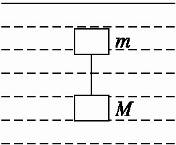问题
问答题
如图12所示,用线将金属块M和木块m连在一起浸没在水中,从静止开始以加速度a加速下沉.经过t1时间,线断了,再经过t2时间,木块停止下沉.求此时金属块M的速度vm.

图12
答案
vm=
在t1时间内,对M与m整体由牛顿第二定律得
(M+m)g-(Fm浮-Fm浮)=(M+m)a ①
在(t1+t2)时间内,对M与m整体由动量定理得
[(M+m)g-(Fm浮-Fm浮)](t1+t2)=Mvm ②
由①②联立得
